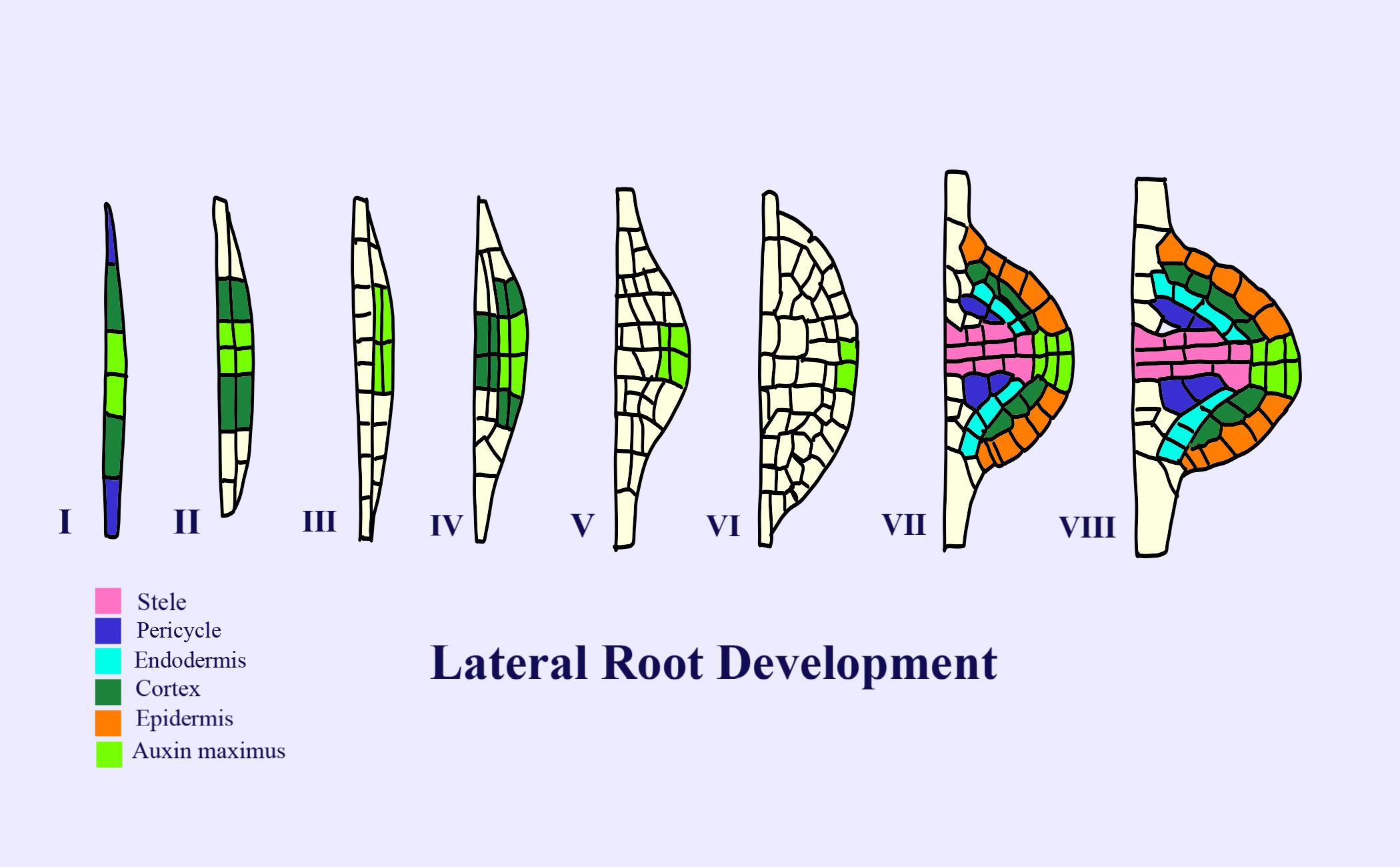
Lateral roots are endogenous in origin as they develop from
(a)Cortex
(b)Endodermis
(c)Pericycle
(d)Vascular strands
Answer
477k+ views
Hint Lateral roots are produced when the layer of cells surrounding the central vascular cylinder, begin to divide, form additional cell layers that push through the outer cell layers of the primary root, and then organize into a second root meristem.
Complete answer:
Lateral roots emerge from the pericycle (meristematic tissue) and extend horizontally from the primary root (radicle). They contribute mainly to anchoring the plant securely into the soil, increasing water uptake, and facilitates the extraction of nutrients required for the growth and development of the plant. Additionally, lateral roots increase the surface area of a plant's root system and can be found in great abundance in several plant species. It has been found that in some cases it forms symbiotic relationships with rhizobia (bacteria) and mycorrhizae (fungi) found in the soil, to further increase surface area and increase nutrient uptake.
Lateral root formation is started in the pericycle that is located between the endodermis and vascular tissue of the root system and begins with a process referred to as priming.
Additional information:
Process of formation of lateral roots:
Stage I: It is the prior most morphologically identifiable stage and involves the asymmetric division of two cells of the pericycle, termed pericycle founder cells, which are adjacent to the protoxylem poles and from which the lateral roots are developed. These cells then undergo further development, causing radial expansion.
Stage II: The miniature central cells then divide parallel to the surface of the plant body in a series of transverse, asymmetric divisions such that the young primordium becomes visible as a projection with an inner layer and an outer layer.
Stages III and IV: Now the outer layer of cells divides so that the primordium is now made of three layers. In the fourth stage, the inner layer undergoes a similar division, such that four cell layers are visible.
Stages V to VIII: Development and further division of four layers eventually result in the emergence of the young lateral root from a parent tissue (the overlying tissue of the primary root) at stage eight.

So, the correct answer is Pericycle.
Notes: The number of lateral roots mainly corresponds to the number of xylem bundles. Additionally, two lateral roots will never be found directly across from one another on the primary root.
Complete answer:
Lateral roots emerge from the pericycle (meristematic tissue) and extend horizontally from the primary root (radicle). They contribute mainly to anchoring the plant securely into the soil, increasing water uptake, and facilitates the extraction of nutrients required for the growth and development of the plant. Additionally, lateral roots increase the surface area of a plant's root system and can be found in great abundance in several plant species. It has been found that in some cases it forms symbiotic relationships with rhizobia (bacteria) and mycorrhizae (fungi) found in the soil, to further increase surface area and increase nutrient uptake.
Lateral root formation is started in the pericycle that is located between the endodermis and vascular tissue of the root system and begins with a process referred to as priming.
Additional information:
Process of formation of lateral roots:
Stage I: It is the prior most morphologically identifiable stage and involves the asymmetric division of two cells of the pericycle, termed pericycle founder cells, which are adjacent to the protoxylem poles and from which the lateral roots are developed. These cells then undergo further development, causing radial expansion.
Stage II: The miniature central cells then divide parallel to the surface of the plant body in a series of transverse, asymmetric divisions such that the young primordium becomes visible as a projection with an inner layer and an outer layer.
Stages III and IV: Now the outer layer of cells divides so that the primordium is now made of three layers. In the fourth stage, the inner layer undergoes a similar division, such that four cell layers are visible.
Stages V to VIII: Development and further division of four layers eventually result in the emergence of the young lateral root from a parent tissue (the overlying tissue of the primary root) at stage eight.

So, the correct answer is Pericycle.
Notes: The number of lateral roots mainly corresponds to the number of xylem bundles. Additionally, two lateral roots will never be found directly across from one another on the primary root.
Latest Vedantu courses for you
Grade 11 Science PCM | CBSE | SCHOOL | English
CBSE (2025-26)
School Full course for CBSE students
₹41,848 per year
Recently Updated Pages
Master Class 11 Economics: Engaging Questions & Answers for Success

Master Class 11 Business Studies: Engaging Questions & Answers for Success

Master Class 11 Accountancy: Engaging Questions & Answers for Success

Master Class 11 English: Engaging Questions & Answers for Success

Master Class 11 Computer Science: Engaging Questions & Answers for Success

Master Class 11 Maths: Engaging Questions & Answers for Success

Trending doubts
State and prove Bernoullis theorem class 11 physics CBSE

1 ton equals to A 100 kg B 1000 kg C 10 kg D 10000 class 11 physics CBSE

State the laws of reflection of light

One Metric ton is equal to kg A 10000 B 1000 C 100 class 11 physics CBSE

1 Quintal is equal to a 110 kg b 10 kg c 100kg d 1000 class 11 physics CBSE

Difference Between Prokaryotic Cells and Eukaryotic Cells




